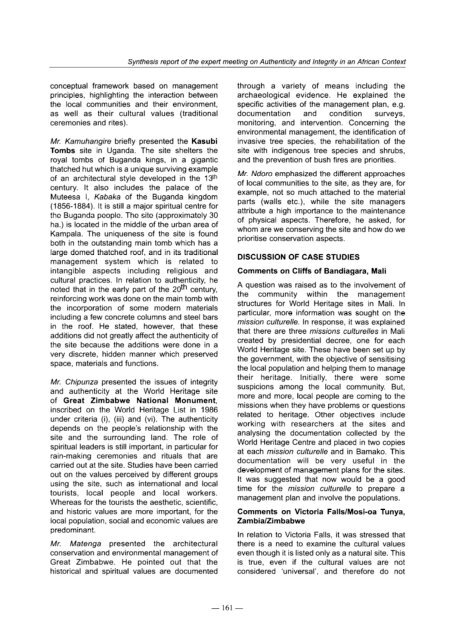Mul - unesdoc - Unesco
Mul - unesdoc - Unesco
Mul - unesdoc - Unesco
Create successful ePaper yourself
Turn your PDF publications into a flip-book with our unique Google optimized e-Paper software.
Synthesis report of the expert meeting on Authenticity and Integrity in an African Context<br />
conceptual framework based on management<br />
principles, highlighting the interaction between<br />
the local communities and their environment,<br />
as well as their cultural values (traditional<br />
ceremonies and rites).<br />
Mr. Kamuhangire briefly presented the Kasubi<br />
Tombs site in Uganda. The site shelters the<br />
royal tombs of Buganda kings, in a gigantic<br />
thatched hut which is a unique surviving example<br />
of an architectural style developed in the 13th<br />
Century. It also includes the palace of the<br />
Muteesa 1, Kabaka of the Buganda kingdom<br />
(1856-1884). It is still a major spiritual centre for<br />
the Buganda people. The site (approximately 30<br />
ha.) is located in the middle of the urban area of<br />
Kampala. The uniqueness of the site is found<br />
both in the outstanding main tomb which has a<br />
large domed thatched roof, and in its traditional<br />
management system which is related to<br />
intangible aspects including religious and<br />
cultural practices. In relation to authenticity, he<br />
noted that in the early part of the 20th Century,<br />
reinforcing work was done on the main tomb with<br />
the incorporation of some modern materials<br />
including a few concrete columns and steel bars<br />
in the roof. He stated, however, that these<br />
additions did not greatly affect the authenticity of<br />
the site because the additions were done in a<br />
very discrete, hidden manner which preserved<br />
space, materials and functions.<br />
Mr. Chipunza presented the issues of integrity<br />
and authenticity at the World Heritage site<br />
of Great Zimbabwe National Monument,<br />
inscribed on the World Heritage List in 1986<br />
under criteria (i), (iii) and (vi). The authenticity<br />
depends on the people’s relationship with the<br />
site and the surrounding land. The role of<br />
spiritual leaders is still important, in particular for<br />
rain-making ceremonies and rituals that are<br />
carried out at the site. Studies have been carried<br />
out on the values perceived by different groups<br />
using the site, such as international and local<br />
tourists, local people and local workers.<br />
Whereas for the tourists the aesthetic, scientific,<br />
and historic values are more important, for the<br />
local population, social and economic values are<br />
predominant.<br />
Mr. Matenga presented the architectural<br />
conservation and environmental management of<br />
Great Zimbabwe. He pointed out that the<br />
historical and spiritual values are documented<br />
- 161-<br />
through a variety of means including the<br />
archaeological evidence. He explained the<br />
specific activities of the management plan, e.g.<br />
documentation and condition surveys,<br />
monitoring, and intervention. Concerning the<br />
environmental management, the identification of<br />
invasive tree species, the rehabilitation of the<br />
site with indigenous tree species and shrubs,<br />
and the prevention of bush fires are priorities.<br />
Mr. Ndoro emphasized the different approaches<br />
of local communities to the site, as they are, for<br />
example, not SO much attached to the material<br />
parts (walls etc.), while the site managers<br />
attribute a high importance to the maintenance<br />
of physical aspects. Therefore, he asked, for<br />
whom are we conserving the site and how do we<br />
prioritise conservation aspects.<br />
DISCUSSION OF CASE STUDIES<br />
Comments on Cliffs of Bandiagara, Mali<br />
A question was raised as to the involvement of<br />
the community within the management<br />
structures for World Heritage sites in Mali. In<br />
particular, more information was sought on the<br />
mission culturelle. In response, it was explained<br />
that there are three missions culturelles in Mali<br />
created by presidential decree, one for each<br />
World Heritage site. These have been set up by<br />
the government, with the objective of sensitising<br />
the local population and helping them to manage<br />
their heritage. Initially, there were some<br />
suspicions among the local community. But,<br />
more and more, local people are coming to the<br />
missions when they have problems or questions<br />
related to heritage. Other objectives include<br />
working with researchers at the sites and<br />
analysing the documentation collected by the<br />
World Heritage Centre and placed in two copies<br />
at each mission culturelle and in Bamako. This<br />
documentation Will be very useful in the<br />
development of management plans for the sites.<br />
It was suggested that now would be a good<br />
time for the mission culturelle to prepare a<br />
management plan and involve the populations.<br />
Comments on Victoria Falls/Mosi-oa Tunya,<br />
ZambialZimbabwe<br />
In relation to Victoria Falls, it was stressed that<br />
there is a need to examine the cultural values<br />
even though it is listed only as a natural site. This<br />
is true, even if the cultural values are not<br />
considered ‘universal’, and therefore do not

















